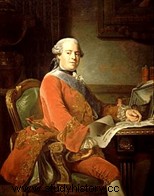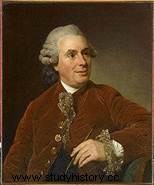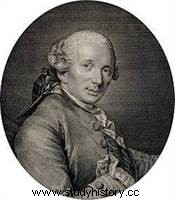 Abel François Poisson, Marquis de Marigny was the Superintendent of Buildings during the reign of Louis XV, in charge of the maintenance and renovation of the palaces and royal residences. In each century, its First Architect and its Director of the King's Buildings. These two characters, in the service of the monarch, inhabited by the same passion for building, must cohabit somehow. This is the case de Marigny , brother of the Marquise de Pompadour, having received the survival of the office of Director of Buildings from his uncle in 1745, when he was only eighteen years old.
Abel François Poisson, Marquis de Marigny was the Superintendent of Buildings during the reign of Louis XV, in charge of the maintenance and renovation of the palaces and royal residences. In each century, its First Architect and its Director of the King's Buildings. These two characters, in the service of the monarch, inhabited by the same passion for building, must cohabit somehow. This is the case de Marigny , brother of the Marquise de Pompadour, having received the survival of the office of Director of Buildings from his uncle in 1745, when he was only eighteen years old.
Abel François Poisson, Marquis of Marigny
Abel, the brother of the new favorite Jeanne de Pompadour, is "a handsome young man, with a delicate complexion like girls". Enrolled in the Royal Academy to obtain a gentleman's education, he then followed Jeanne to Versailles and received, at the age of eighteen, the survival of the office of his uncle Charles François Paul Le Normant de Tournehem, as "Director of the King's Buildings, Arts , Gardens and Manufactures”, with a pension of 8,000 pounds. Everything goes a little too fast for the young man:he is invited to the king's meal, seated next to him, called "little brother" by the monarch, all sly and jealous eyes turned towards him. He is young and does not care about these idiotic reactions, but we are "waiting for him at the turn", we are already slandering!
To complete her education, Jeanne sends her brother for a Grand Tour in Italy. She prepares this trip on the model of that of Colbert for her own son, adding the Abbé Le Blanc a man of letters, Charles Nicolas Cochin a designer-engraver of great talent who has delicacy and great accuracy in his drawings. as well as Jacques Germain Soufflot, a very innovative architect from Lyon. The financier Pâris de Montmartel takes care of the financial means, the uncle de Tournehem provides personal funds to the young Abel, because he will have to lead a certain lifestyle during the performances and other invitations.
 Between December 1749 and September 1751, this little outfit was presented to the king in Turin, then visited his theater much more practical and comfortable than the French theatre, especially for long performances of four hours, the Saint Laurent church resembling anything but a religious building with its concave shapes and its light which comes from above; then Parma, Modena, Rome and the visit of the Mancini palace housing the French Academy, without forgetting the blessing of the pope; Naples and the unmissable Venice.
Between December 1749 and September 1751, this little outfit was presented to the king in Turin, then visited his theater much more practical and comfortable than the French theatre, especially for long performances of four hours, the Saint Laurent church resembling anything but a religious building with its concave shapes and its light which comes from above; then Parma, Modena, Rome and the visit of the Mancini palace housing the French Academy, without forgetting the blessing of the pope; Naples and the unmissable Venice.
Soufflot happily comments on each building, Cochin reproduces these beauties and brings out the best in each work, Abel no longer knows where to look, he likes everything, all the enthusiasm, all marvel, they succeeded in exalting the young man who was then seized with a real passion for building. After alarming news about Uncle Tournehem's state of health, the trip had to be cut short. Abel returns just in time, his uncle dies in November.
Marigny, Superintendent of Buildings
This title brings together several tasks concerning buildings with the construction and maintenance of royal residences, public monuments, as well as works of general interest such as the design of the future Place Louis XV; the Savonnerie, Gobelins and Sèvres factories; the Versailles road network; but also work on green spaces, gardens and parks with various plantings and/or uprooting, acquisitions and state management. Added to this are the links with the Royal Academies, the minutes, the inventories of works of art, the requests of the artists installed in the Louvre as well as all the purely administrative work such as memoirs, letters, accounting for receipts and expenses in the "Registers of the King's Buildings", miscellaneous claims from staff (this administration employs 250 to 300 people).
In November 1751, when he took office, Abel was not too lost, his uncle having told him everything, explained everything. He will carry out his tasks with brio, intelligence and tact for twenty-two years, until his retirement in 1773:restoration of the apartments of Versailles, agreements on certain works requested, repairs, improvements in heating, installation of bathtubs and new ice, planting of 85,000 trees and shrubs. But he wants other things, he wants to think about real projects, in the company of Soufflot and Cochin, the three of whom have become inseparable.
Since 1748, the construction of a new Place Louis XV has been under study, to celebrate the recovery of the sick king in Metz in 1743. In the middle of this place would be installed the statue of the king, created by Bouchardon, but it requires a grandiose and prestigious setting. Paris has no more places available, it is thought to cut down unhealthy parts and in 1750, the king offers a piece of land, at the end of the Tuileries garden, in reality it is a vast quagmire! Marigny did not panic, he wanted his first project to succeed and began discussions with Gabriel, the king's first architect.
With Soufflot, who became Comptroller of Buildings in 1753, he imagined a new design square, open on three sides, keeping the Tuileries gardens on both sides and the perspective of the Champs Elysées where he had the gardens landscaped and planted several different types of trees. The statue was completed in 1758 and the square inaugurated in 1763. Work continued in this district with the Garde Meubles building begun in 1768, the new rue Royale and at the end the Madeleine church, the first stone of which had been laid by the king in 1763 and the plans inspired by Soufflot's project for the Sainte Geneviève church.
 Always in honor of his recovery in 1743, the king wishes to dedicate a new church to Saint Geneviève. The architect Gabriel and his old principles is ousted in favor of Soufflot, more innovative. The land chosen was blessed in 1758, work could begin, Marigny and Soufflot were happy. The church would be "modern" by taking the model of what is done in Italy and England, a Greek cross plan, a stone vault like the religious buildings of the Middle Ages but with a dome and the relics of Saint Geneviève in the center. under the dome.
Always in honor of his recovery in 1743, the king wishes to dedicate a new church to Saint Geneviève. The architect Gabriel and his old principles is ousted in favor of Soufflot, more innovative. The land chosen was blessed in 1758, work could begin, Marigny and Soufflot were happy. The church would be "modern" by taking the model of what is done in Italy and England, a Greek cross plan, a stone vault like the religious buildings of the Middle Ages but with a dome and the relics of Saint Geneviève in the center. under the dome.
The first stone laid in 1764 gives rise to a moving and grandiose reception, the festivities are at the height of the future church:a painted canvas mounted on a wooden frame represents the he finished state of the church, a superb trompe l'oeil, the king is conquered, Marigny then knows a moment of happiness and pride. This is the consecration of Soufflot. But a few years later, Soufflot's project was called into question, accused of not having calculated everything, the pillars not going to support such a load, the cabal spreading abroad. Soufflot has collapsed, Marigny asks for an expertise that demonstrates the opposite, the honor of the architect from Lyon who has become Parisian is safe!
Marigny is still busy with the Louvre:the barracks to be demolished, the merchants to be moved, a roof to be built on the east and north wings as well as the unfinished column by Perrault, the artists' accommodation to be enlarged, to be better heated in winter and ventilated in summer. He entrusts this mission to Soufflot and Cochin who have just received "custody of the king's drawings" since Charles Antoine Coypel, the king's first painter is dead. Encouraging history painting, he commissioned paintings from Jean Baptiste Marie Pierre, Boucher, Van Loo First painter to the king after Coypel, until his death in 1765, replaced by Boucher.
In 1763, the opera house at the Tuileries went up in smoke. Soufflot easily obtains the project since he had realized the opera of Lyon. The room will be identical to the previous one and without any modification, the opening takes place eight months later in January 1764. But Paris needs a theater, Marigny grants the site of our current Odeon theater to Charles de Wailly and work began in 1780.
Among other works, there are always the same requests for the apartments of Versailles, but few important projects, the Seven Years War no longer allowing funds to be allocated to Buildings. Apart from a driveway drilled from the Champs Elysées to Neuilly to replace the old bridge with a new one in stone in 1774, Marigny proposed to the king to transform the old royal palace, abandoned and to make it a permanent museum. This project, taken up in 1776 by the Comte d'Angiviller, successor to Marigny, would not see its realization until 1793 under the name of Museum Central des Arts. The Champs Elysées district was transformed, part of it took the name of "Carré Marigny", the Hôtel d'Evreux (our current Elysée Palace) was refurbished by his sister Jeanne de Pompadour, the gardens were transformed to obtain a perspective to the Invalides and the avenue de Marigny is drawn in 1770.
Marigny's resignation
Despite the "blue ribbon of the Order of Saint Esprit" received in 1756, despite the confidence and great esteem of the king, Marigny felt that he was going to have to abandon his post in the spring of 1772:Father Terray was appointed financial controller, the building funds were blocked. In 1771, half of the credits allocated for the year 1766 had not been paid! Nothing is maintained anymore, neither the roads, nor the gardens, nor the parks, nor the apartments of Versailles, even less those of the Louvre, the employees are not paid, the worse the aqueduct of Versailles collapses and drowns all The valley ! Father Terray does nothing, does not move and turns against Marigny. With the help of Madame Du Barry, he mounts a cabal against him, he wants his job, to take his revenge on Madame de Pompadour.
The Marquis de Marigny preferred to leave:he left Versailles on July 27, 1773, after twenty-two years of loyalty to the king as superintendent of the King's Buildings, Arts, Gardens and Manufactures, thing rare in the 18th century.
To go further
- Marigny's dream, by Monique Demagny. Editions JC Lattès, March 2013.
